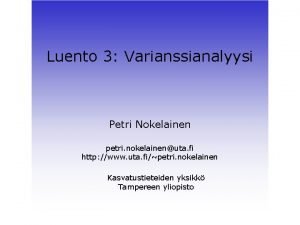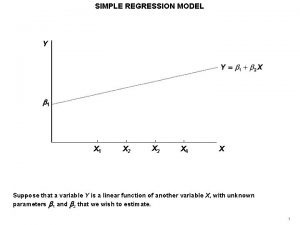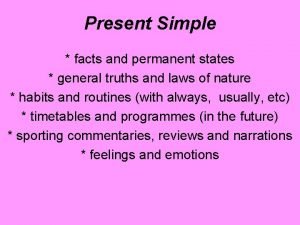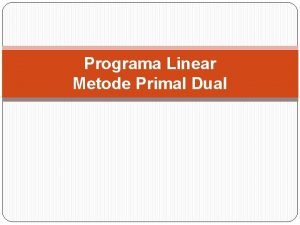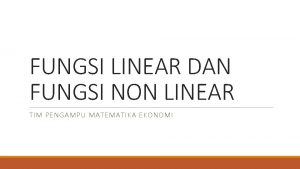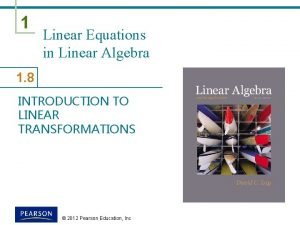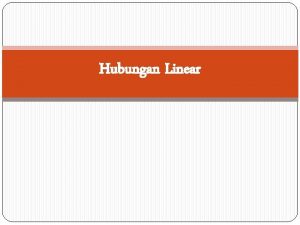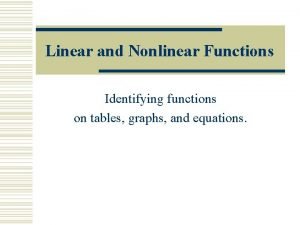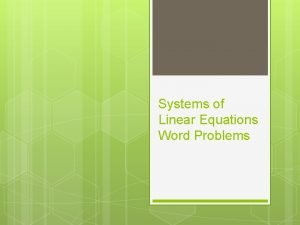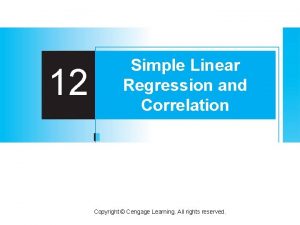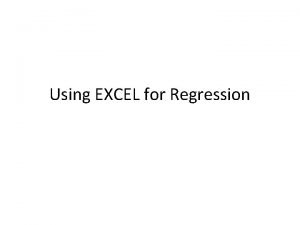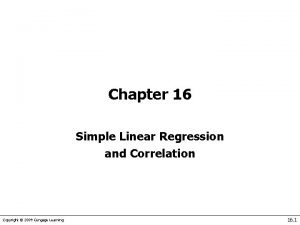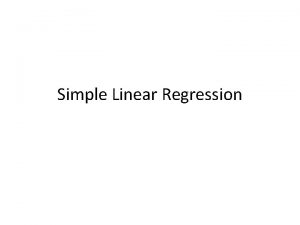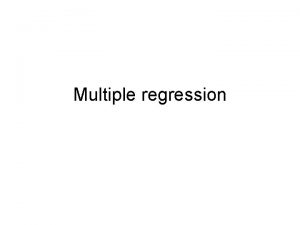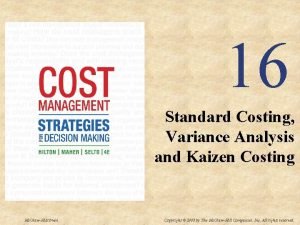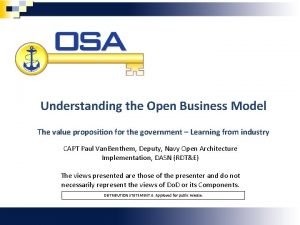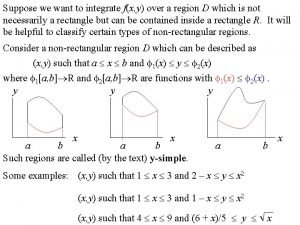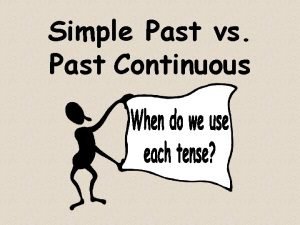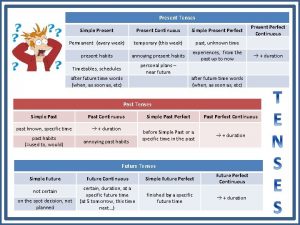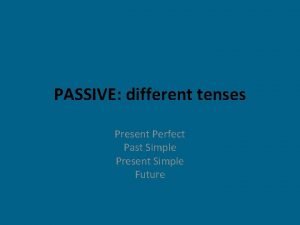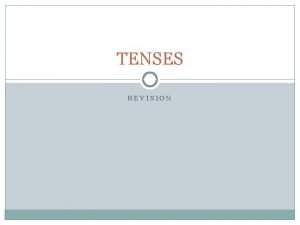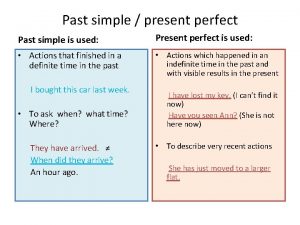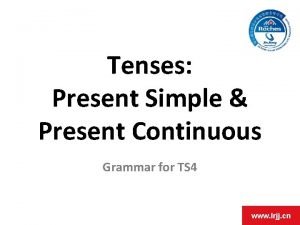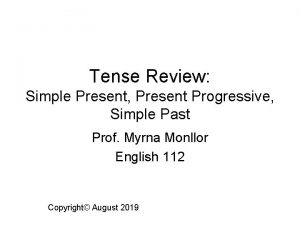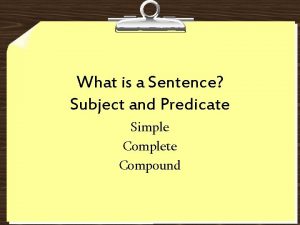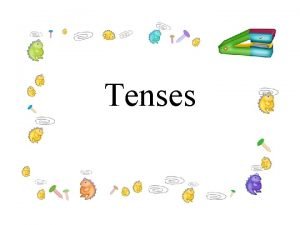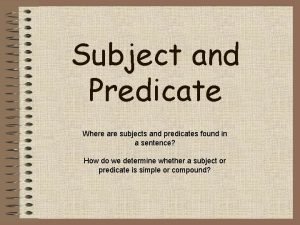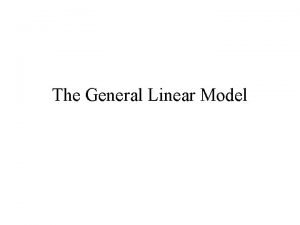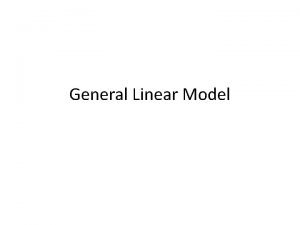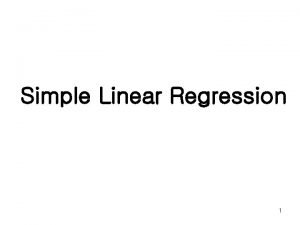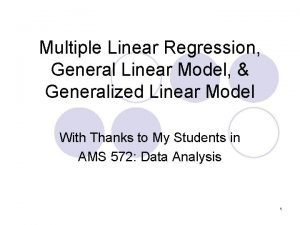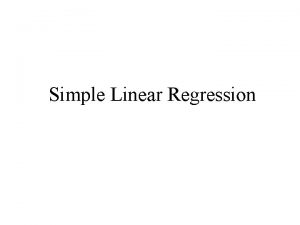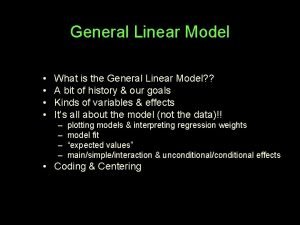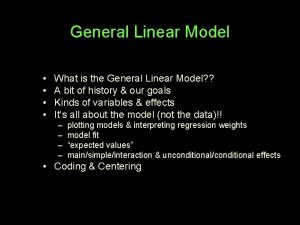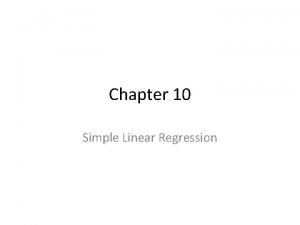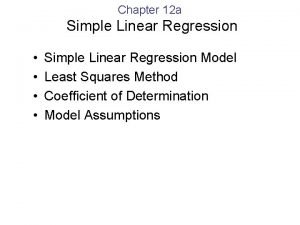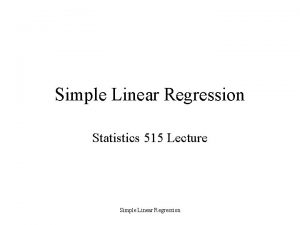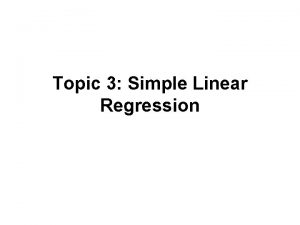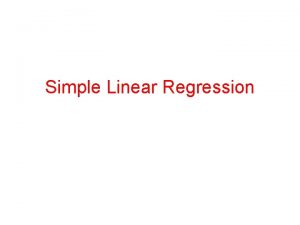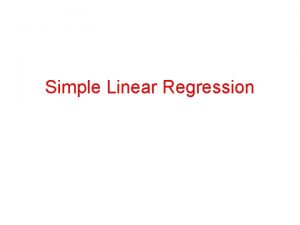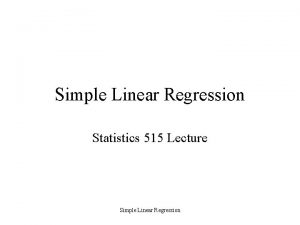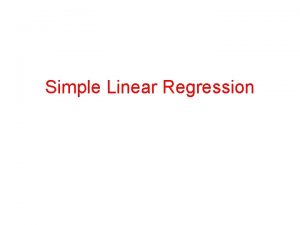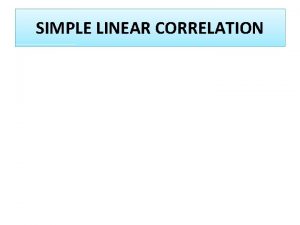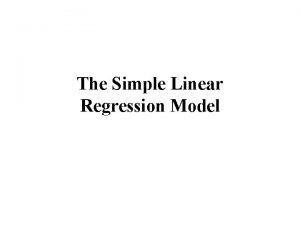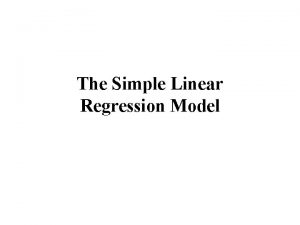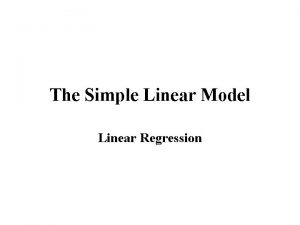The General Linear Model The Simple Linear Model












































![Consider the random variable Y with 1. E[Y] = b 1 X 1+ b Consider the random variable Y with 1. E[Y] = b 1 X 1+ b](https://slidetodoc.com/presentation_image_h/7e4b98e314ecc48a7fe954361bb7a714/image-45.jpg)






















![If [X'X]-1 exists then the normal equations have solution: and If [X'X]-1 exists then the normal equations have solution: and](https://slidetodoc.com/presentation_image_h/7e4b98e314ecc48a7fe954361bb7a714/image-68.jpg)




























![Consider the random variable Y with 1. E[Y] = b 0+ b 1 X Consider the random variable Y with 1. E[Y] = b 0+ b 1 X](https://slidetodoc.com/presentation_image_h/7e4b98e314ecc48a7fe954361bb7a714/image-97.jpg)





















- Slides: 118

The General Linear Model

The Simple Linear Model Linear Regression

Suppose that we have two variables 1. Y – the dependent variable (response variable) 2. X – the independent variable (explanatory variable, factor)

X , the independent variable may or may not be a random variable. Sometimes it is randomly observed. Sometimes specific values of X are selected

The dependent variable, Y, is assumed to be a random variable. The distribution of Y is dependent on X The object is to determine that distribution using statistical techniques. (Estimation and Hypothesis Testing)

These decisions will be based on data collected on both variable Y (the dependent variable) and X (the independent variable). Let (x 1, y 1), (x 2, y 2), … , (xn, yn) denote n pairs of values measured on the independent variable (X) and the dependent variable (Y) The scatterplot: The graphical plot of the points: (x 1, y 1), (x 2, y 2), … , (xn, yn)

Assume that we have collected data on two variables X and Y. Let (x 1, y 1) (x 2, y 2) (x 3, y 3) … (xn, yn) denote the pairs of measurements on the on two variables X and Y for n cases in a sample (or population)

The assumption will be made that y 1, y 2, y 3 …, yn are 1. 2. 3. 4. independent random variables. Normally distributed. Have the common variance, s. The mean of yi is mi = a + bxi Data that satisfies the assumptions above is to come from the Simple Linear Model

Each yi is assumed to be randomly generated from a normal distribution with mean mi = a + bxi and standard deviation s. yi s a + bxi xi

• When data is correlated it falls roughly about a straight line.

The density of yi is: The joint density of y 1 , y 2 , …, yn is:

Estimation of the parameters the intercept a the slope b the standard deviation s (or variance s 2)

The Least Squares Line Fitting the best straight line to “linear” data

Let Y=a +b. X denote an arbitrary equation of a straight line. a and b are known values. This equation can be used to predict for each value of X, the value of Y. For example, if X = xi (as for the ith case) then the predicted value of Y is:

Define the residual for each case in the sample to be: The residual sum of squares (RSS) is defined as: The residual sum of squares (RSS) is a measure of the “goodness of fit of the line Y = a + b. X to the data

One choice of a and b will result in the residual sum of squares attaining a minimum. If this is the case than the line: Y = a + b. X is called the Least Squares Line

To find the Least Squares estimates, a and b, we need to solve the equations: and

Note: or and

Note: or

Hence the optimal values of a and b satisfy the equations: and From the first equation we have: The second equation becomes:

Solving the second equation for b: and where and

Note: and Proof

Summary: Slope and intercept of the least squares Line and

Maximum Likelihood Estimation of the parameters the intercept a the slope b the standard deviation s

Recall The joint density of y 1 , y 2 , …, yn is: = the Likelihood function

the log Likelihood function To find the maximum Likelihood estimates of a, b and s we need to solve the equations:

becomes These are the same equations for the least squares line which have solution:

The third equation: becomes

Summary: Maximum Likelihood Estimates and

A computing formula for the estimate of s 2 and Hence

Now Hence

It also can be shown that Thus , the maximum likelihood estimator of s 2, is a biased estimator of s 2. This estimator can be easily converted into an unbiased estimator of s 2 by multiply by the ratio n/(n – 2)

Estimators in Linear Regression and

The major computation is :

Computing Formulae:

Application Of Statistical Theory to simple Linear Regression We will now use statistical theory to prove optimal properties of the estimators. Recall, the joint density of y 1 , y 2 , …, yn is:




Also and Thus all three estimators are functions of the set of complete sufficient statistics. If they are also unbiased then they are Uniform Minimum Variance Unbiased (UMVU) estimators (using the Lehmann-Scheffe theorem)

We have already shown that s 2 is an unbiased estimator of s 2. We need only show that: and are unbiased estimators of b and a.

Thus are unbiased estimators of b and a.

Also Thus

The General Linear Model
![Consider the random variable Y with 1 EY b 1 X 1 b Consider the random variable Y with 1. E[Y] = b 1 X 1+ b](https://slidetodoc.com/presentation_image_h/7e4b98e314ecc48a7fe954361bb7a714/image-45.jpg)
Consider the random variable Y with 1. E[Y] = b 1 X 1+ b 2 X 2 +. . . + bp. Xp (alternatively E[Y] = b 0+ b 1 X 1+. . . + bp. Xp, intercept included) and 2. var(Y) = s 2 • where b 1, b 2 , . . . , bp are unknown parameters • and X 1 , X 2 , . . . , Xp are nonrandom variables. • Assume further that Y is normally distributed.

Thus the density of Y is: f(Y|b 1, b 2 , . . . , bp, s 2) = f(Y| , s 2)

Now suppose that n independent observations of Y, (y 1, y 2, . . . , yn) are made corresponding to n sets of values of (X 1 , X 2 , . . . , Xp) (x 11 , x 12 , . . . , x 1 p), (x 21 , x 22 , . . . , x 2 p), . . . (xn 1 , xn 2 , . . . , xnp). Then the joint density of y = (y 1, y 2, . . . yn) is: f(y 1, y 2, . . . , yn|b 1, b 2 , . . . , bp, s 2) =


Thus is a member of the exponential family of distributions And is a Minimal Complete set of Sufficient Statistics.

Matrix-vector formulation The General Linear Model


The General Linear Model

Geometrical interpretation of the General Linear Model

Geometical interpretation of the General Linear Model

Estimation The General Linear Model

Least squares estimates of b Let

The Equations for the Least squares estimates

Written out in full These equations are called the Normal Equations

Matrix development of the Normal Equations Now The Normal Equations

Summary (the Least Squares Estimates) The Least Squares estimates satisfy The Normal Equations

Note: Some matrix properties Rank rank(AB) = min(rank(A), rank(B)) rank(A) ≤ min(# rows of A, # cols of A ) rank(A) = rank(A ) Consider the normal equations

then the solution to the normal equations

Maximum Likelihood Estimation General Linear Model

The General Linear Model

The Maximum Likelihood estimates of b and s 2 are the values that maximize or equivalently

This yields the system of linear equations (The Normal Equations)

yields the equation:
![If XX1 exists then the normal equations have solution and If [X'X]-1 exists then the normal equations have solution: and](https://slidetodoc.com/presentation_image_h/7e4b98e314ecc48a7fe954361bb7a714/image-68.jpg)
If [X'X]-1 exists then the normal equations have solution: and

Summary and

Comments The matrices are symmetric idempotent matrices also

Comments (continued)

Geometry of Least Squares

Example • Data is collected for n = 15 cases on the variables Y (the dependent variable) and X 1, X 2, X 3 and X 4. • The data and calculations are displayed on the next page:



Properties of The Maximum Likelihood Estimates Unbiasedness, Minimum Variance

Note: and Thus is an unbiased estimator of. Since is also a function of the set of complete minimal sufficient statistics, it is the UMVU estimator of. (Lehman-Scheffe)

Note: where In general

Thus: where

Thus:

Let Then Thus s 2 is an unbiased estimator of s 2. Since s 2 is also a function of the set of complete minimal sufficient statistics, it is the UMVU estimator of s 2.

Distributional Properties Least square Estimates (Maximum Likelidood estimates)

Recall 1. If ~ then A is a q × p matrix where

The General Linear Model The Estimates and

Theorem Proof




Finally and

Thus are independent. Summary

Example • Data is collected for n = 15 cases on the variables Y (the dependent variable) and X 1, X 2, X 3 and X 4. • The data and calculations are displayed on the next page:




Estimates of the coefficients Compare with SPSS output

The General Linear Model with an intercept
![Consider the random variable Y with 1 EY b 0 b 1 X Consider the random variable Y with 1. E[Y] = b 0+ b 1 X](https://slidetodoc.com/presentation_image_h/7e4b98e314ecc48a7fe954361bb7a714/image-97.jpg)
Consider the random variable Y with 1. E[Y] = b 0+ b 1 X 1+ b 2 X 2 +. . . + bp. Xp (intercept included) and 2. var(Y) = s 2 • where b 1, b 2 , . . . , bp are unknown parameters • and X 1 , X 2 , . . . , Xp are nonrandom variables. • Assume further that Y is normally distributed.

The matrix formulation (intercept included) Then the model becomes Thus to include an intercept add an extra column of 1’s in the design matrix X and include the intercept in the parameter vector

The matrix formulation of the Simple Linear regression model

and Now

thus

Finally Thus

The Gauss-Markov Theorem An important result in theory of Linear models Proves optimality of Least squares estimates in a more general setting

Assume the following model Linear Model We will not necessarily assume Normality. Consider the least squares estimate of is an unbiased linear estimator of

The Gauss-Markov Theorem Assume Consider the least squares estimate of and , an unbiased linear estimator of Let denote any other unbiased linear estimator of

Proof Now

Now Also Thus is an unbiased estimator of if

Thus The Gauss-Markov theorem states that is the Best Linear Unbiased Estimator (B. L. U. E. ) of

Hypothesis testing for the GLM The General Linear Hypothesis

Testing the General Linear Hypotheses The General Linear Hypothesis h 11 b 1 + h 12 b 2 + h 13 b 3 +. . . + h 1 pbp = h 1 h 21 b 1 + h 22 b 2 + h 23 b 3 +. . . + h 2 pbp = h 2. . . hq 1 b 1 + hq 2 b 2 + hq 3 b 3 +. . . + hqpbp = hq where h 11, h 12, h 13, . . . , hqp and h 1, h 2, h 3, . . . , hq are known coefficients. In matrix notation H 0:

Examples 1. H 0: b 1 = 0 2. H 0: b 1 = 0, b 2 = 0, b 3 = 0 3. H 0: b 1 = b 2

Examples 4. H 0: b 1 = b 2 , b 3 = b 4 5. H 0: b 1 = 1/2(b 2 + b 3) 6. H 0: b 1 = 1/2(b 2 + b 3), b 3 = 1/3(b 4 + b 5 + b 6)

The. Likelihood Ratio Test The joint density of is: The likelihood function The log-likelihood function

Defn (Likelihood Ratio Test of size a) Rejects H 0: q w against the alternative hypothesis H 1: q w. when and K is chosen so that

Note We will maximize. The Lagrange multiplier technique will be used for this purpose

We will maximize.

or finally or

Thus the equations for are Now or and
 Simple and multiple linear regression
Simple and multiple linear regression Minitab general linear model
Minitab general linear model Nominaaliasteikollinen muuttuja
Nominaaliasteikollinen muuttuja Simple past future
Simple past future Simple present and simple future
Simple present and simple future Past simple future
Past simple future Without information
Without information Simple past simple present simple future
Simple past simple present simple future Present continuous present simple past simple exercise
Present continuous present simple past simple exercise Simple present simple past simple future
Simple present simple past simple future Presente simples de work
Presente simples de work Future simple present simple
Future simple present simple Diferencia entre gran plano general y plano general
Diferencia entre gran plano general y plano general Where did general lee surrender to general grant?
Where did general lee surrender to general grant? Least square method
Least square method Hình ảnh bộ gõ cơ thể búng tay
Hình ảnh bộ gõ cơ thể búng tay Lp html
Lp html Bổ thể
Bổ thể Tỉ lệ cơ thể trẻ em
Tỉ lệ cơ thể trẻ em Chó sói
Chó sói Glasgow thang điểm
Glasgow thang điểm Chúa yêu trần thế
Chúa yêu trần thế Các môn thể thao bắt đầu bằng tiếng nhảy
Các môn thể thao bắt đầu bằng tiếng nhảy Thế nào là hệ số cao nhất
Thế nào là hệ số cao nhất Các châu lục và đại dương trên thế giới
Các châu lục và đại dương trên thế giới Công thức tiính động năng
Công thức tiính động năng Trời xanh đây là của chúng ta thể thơ
Trời xanh đây là của chúng ta thể thơ Mật thư tọa độ 5x5
Mật thư tọa độ 5x5 Làm thế nào để 102-1=99
Làm thế nào để 102-1=99 Phản ứng thế ankan
Phản ứng thế ankan Các châu lục và đại dương trên thế giới
Các châu lục và đại dương trên thế giới Thể thơ truyền thống
Thể thơ truyền thống Quá trình desamine hóa có thể tạo ra
Quá trình desamine hóa có thể tạo ra Một số thể thơ truyền thống
Một số thể thơ truyền thống Cái miệng nó xinh thế chỉ nói điều hay thôi
Cái miệng nó xinh thế chỉ nói điều hay thôi Vẽ hình chiếu vuông góc của vật thể sau
Vẽ hình chiếu vuông góc của vật thể sau Biện pháp chống mỏi cơ
Biện pháp chống mỏi cơ đặc điểm cơ thể của người tối cổ
đặc điểm cơ thể của người tối cổ Thế nào là giọng cùng tên
Thế nào là giọng cùng tên Vẽ hình chiếu đứng bằng cạnh của vật thể
Vẽ hình chiếu đứng bằng cạnh của vật thể Vẽ hình chiếu vuông góc của vật thể sau
Vẽ hình chiếu vuông góc của vật thể sau Thẻ vin
Thẻ vin đại từ thay thế
đại từ thay thế điện thế nghỉ
điện thế nghỉ Tư thế ngồi viết
Tư thế ngồi viết Diễn thế sinh thái là
Diễn thế sinh thái là Dot
Dot Các số nguyên tố
Các số nguyên tố Tư thế ngồi viết
Tư thế ngồi viết Lời thề hippocrates
Lời thề hippocrates Thiếu nhi thế giới liên hoan
Thiếu nhi thế giới liên hoan ưu thế lai là gì
ưu thế lai là gì Hổ sinh sản vào mùa nào
Hổ sinh sản vào mùa nào Sự nuôi và dạy con của hươu
Sự nuôi và dạy con của hươu Sơ đồ cơ thể người
Sơ đồ cơ thể người Từ ngữ thể hiện lòng nhân hậu
Từ ngữ thể hiện lòng nhân hậu Thế nào là mạng điện lắp đặt kiểu nổi
Thế nào là mạng điện lắp đặt kiểu nổi Permanent action present simple
Permanent action present simple Psychological noise
Psychological noise Primal-dual
Primal-dual Contoh soal metode biseksi dan penyelesaiannya
Contoh soal metode biseksi dan penyelesaiannya Different types houses
Different types houses Non liner plot
Non liner plot Contoh soal persamaan non linier metode biseksi
Contoh soal persamaan non linier metode biseksi Linear and nonlinear pipeline
Linear and nonlinear pipeline Linear and non linear multimedia
Linear and non linear multimedia Linear grammar
Linear grammar Perbedaan fungsi linier dan non linier
Perbedaan fungsi linier dan non linier Pengertian fungsi linear dan non linear
Pengertian fungsi linear dan non linear Linearly dependent vectors
Linearly dependent vectors Linear algebra linear transformation
Linear algebra linear transformation Lereng dan penggal garis
Lereng dan penggal garis Linear impulse
Linear impulse Persamaan diferensial simultan
Persamaan diferensial simultan Nonlinear function table
Nonlinear function table Linear or nonlinear
Linear or nonlinear Difference between linear and nonlinear equations
Difference between linear and nonlinear equations Nonlinear video editing
Nonlinear video editing Persamaan linier 1 variabel
Persamaan linier 1 variabel Closure properties of regular languages
Closure properties of regular languages Textos narrativos para copiar
Textos narrativos para copiar System of linear equations word problems
System of linear equations word problems Simple regression hypothesis
Simple regression hypothesis Excel
Excel Simple linear regression
Simple linear regression Simple linear regression
Simple linear regression Linear equations
Linear equations Linear regression assumptions spss
Linear regression assumptions spss Standard costing vs kaizen costing
Standard costing vs kaizen costing General motors business model canvas
General motors business model canvas Basic tools in making simple electrical gadgets
Basic tools in making simple electrical gadgets X simple and y simple
X simple and y simple Simple subject definition
Simple subject definition Simple past vs past continuous
Simple past vs past continuous Present simple tense eat
Present simple tense eat Past perfect continuous simple
Past perfect continuous simple Past simple signaalwoorden
Past simple signaalwoorden Present simple passive
Present simple passive Diferencias entre presente simple y pasado simple
Diferencias entre presente simple y pasado simple What is the bankers rule
What is the bankers rule Passive voice of present simple
Passive voice of present simple Passive voice simple present and simple past exercises
Passive voice simple present and simple past exercises Functions of present continuous tense
Functions of present continuous tense Present simple present continuous past simple
Present simple present continuous past simple Past participle verbs meet
Past participle verbs meet Present simple present continuous past simple
Present simple present continuous past simple Present simple be and other verbs
Present simple be and other verbs Simple present tense review
Simple present tense review If+simple present
If+simple present Simple past vs simple present
Simple past vs simple present When we use the past simple
When we use the past simple Yesterday present simple
Yesterday present simple If-clause and main clause
If-clause and main clause Simple past in reported speech
Simple past in reported speech Simple predicet
Simple predicet Simple present tense
Simple present tense Simple predicate
Simple predicate Simple predicate
Simple predicate Bepast participle
Bepast participle


